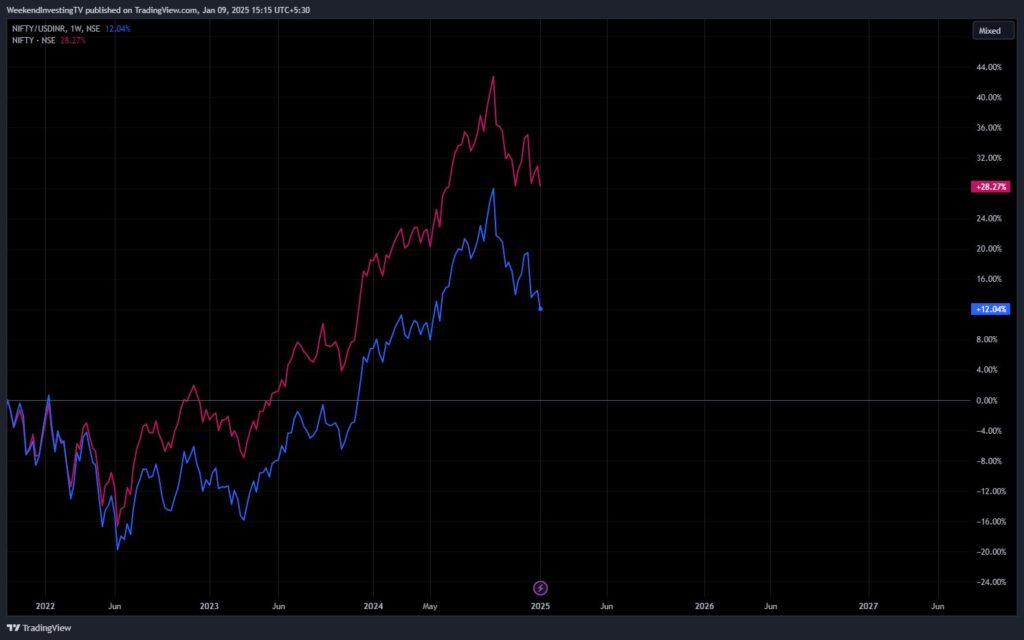Understanding Nifty’s Returns: Rupee vs. Dollar Perspective
A fascinating analysis of Nifty reveals a stark contrast between its performance in rupee terms and US dollar terms. While Nifty has risen by 28% over the last three years in rupee terms, the return in dollar terms is only 12% as of January 9. This discrepancy highlights the challenges faced by foreign investors and the implications for India’s attractiveness in global markets.

Rupee vs. Dollar Returns: The Key Difference
Rupee Perspective: Domestic investors measure returns in rupees, where Nifty has shown a healthy 28% growth over three years.
Dollar Perspective: For foreign investors, Nifty’s dollar-denominated returns stand at a modest 12%, significantly underperforming other markets like the S&P 500, which delivered 30-40% returns in the same period.
This gap is primarily due to the rupee’s depreciation against the US dollar, eroding gains for foreign investors.
Why Foreign Investors Are Selling
Low Dollar Returns: With just 12% returns in three years, Indian markets are underwhelming for global investors compared to the returns available in other markets like the US.
Opportunity Cost: Foreign Institutional Investors (FIIs) seek markets that offer better returns relative to their risk. The underperformance of Nifty in dollar terms makes India less attractive compared to alternatives like the S&P 500.
Global Benchmarks: FIIs compare Indian markets to global benchmarks, and poor dollar returns deter investments.
The Impact of Poor Dollar Returns
Reduced FII Inflows: The lack of competitive returns in dollar terms discourages foreign capital, leading to net outflows and additional selling pressure.
Market Sentiment: FIIs are major players in Indian markets. Their reduced interest affects sentiment and can contribute to a bearish outlook.
Rebound Potential: While the current tide is against Indian markets, FIIs tend to follow price trends. When Nifty regains momentum, FIIs may return in force.
For Indian investors, it’s essential to recognize the difference between rupee and dollar-based returns, as it highlights India’s position in the global market. While domestic investors may not feel the direct impact of currency depreciation, understanding this aspect provides a broader perspective on the long-term competitiveness of Indian markets. It also emphasizes the importance of diversifying portfolios to include global investments, ensuring exposure to opportunities outside the Indian market and mitigating currency risks.
India’s current underperformance in dollar terms may be a temporary phase, but it reflects a crucial dynamic for investors to watch. As market cycles shift, the same FIIs selling today could become aggressive buyers tomorrow when conditions turn favorable. For this to happen, the rupee must stabilize or returns in dollar terms must improve to align more closely with global benchmarks. Until then, it is vital for investors to focus on long-term strategies and not lose sight of the bigger picture amidst short-term challenges.
WeekendInvesting launches – PortfolioMomentum Report
Momentum Score: See what percentage of your portfolio is in high vs. low momentum stocks, giving you a snapshot of its performance and health.
Weightage Skew: Discover if certain stocks are dominating your portfolio, affecting its performance and risk balance.
Why it matters
Weak momentum stocks can limit your gains, while high momentum stocks improve capital allocation, enhancing your chances of superior performance.
Disclaimers and disclosures : https://tinyurl.com/2763eyaz










